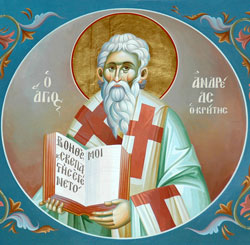
Feastday: July 4
St. Andrew of Crete whose "Great Canon" the Orthodox pray during Lent, was born in Damascus. He became a monk at Mar Saba and served later at the Holy Sepulchre. Around 685, he was ordained a deacon at Hagia Sophia. He also ran a refuge that took in orphans and cared for the elderly. He ended his days as Archbishop of Gortyna, a position to which he was elevated in 692, on the island of Crete. He wrote homilies that display great oratorical skill, as well as panegyrics to the saints. Some say that he invented the canon.
For the martyr of 766 of the same name, see Andrew of Crete (martyr).Andrew of Crete (Greek: Ἀνδρέας Κρήτης, c. 650 – July 4, 712 or 726 or 740), also known as Andrew of Jerusalem, was an 8th-century bishop, theologian, homilist, and hymnographer. He is venerated as a saint by Eastern Orthodoxy and the Catholic Church.
Life
Born in Damascus in c. 650, to Christian parents. From birth, Andrew was a mute until he was the age of seven. According to his hagiographers, he was miraculously cured after receiving Holy Communion. He began his ecclesiastical career at fourteen in the Lavra of St. Sabbas the Sanctified, near Jerusalem, where he quickly gained the notice of his superiors. Theodore, the locum tenens of the Patriarchate of Jerusalem (745–770) made him his Archdeacon, and sent him to the imperial capital of Constantinople as his official representative at the Sixth Ecumenical Council (680–681), which had been called by the Emperor Constantine Pogonatus, to counter the heresy of Monothelitism.
Shortly after the Council he was summoned back to Constantinople from Jerusalem and was appointed Archdeacon at the "Great Church" of Hagia Sophia. Eventually, Andrew was appointed to the metropolitan see of Gortyna, in Crete. Although he had been an opponent of the Monothelite heresy, he nevertheless attended the conciliabulum of 712, in which the decrees of the Ecumenical Council were abolished. But in the following year he repented and returned to orthodoxy. Thereafter, he occupied himself with preaching, composing hymns, etc. As a preacher, his discourses are known for their dignified and harmonious phraseology, for which he is considered to be one of the foremost ecclesiastical orators of the Byzantine epoch.
Church historians are not of the same opinion as to the date of his death. What is known is that he died on the island of Mytilene, while returning to Crete from Constantinople, where he had been on church business. His relics were later transferred to Constantinople. In the year 1350 the pious Russian pilgrim Stefan of Novgorod saw his relics at the Monastery of Saint Andrew of Crete in Constantinople. At modern Skala Eresou on Lesbos (ancient Eresos) is a large Early Christian basilical church in honour of St. Andrew.
The feast day of Saint Andrew of Crete is July 4 on the Eastern Orthodox liturgical calendar (for those churches which follow the Julian Calendar, July 4 falls on July 17 of the Gregorian Calendar).
Hymnography
Today, Saint Andrew is primarily known as a hymnographer. He is credited with the invention (or at least the introduction into Orthodox liturgical services) of the canon, a new form of hymnody. Previously, the portion of the Matins service which is now the canon was composed of chanting the nine biblical canticles, with short refrains inserted between the scripture verses. Saint Andrew expanded these refrains into fully developed poetic Odes, each of which begins with the theme (Irmos) of the scriptural canticle, but then goes on to expound the theme of the feast being celebrated that day (whether the Lord, the Theotokos, a saint, the departed, etc.).
His masterpiece, the Great Canon (also known as the Canon of Repentance or the Great Canon of Repentance), is the longest canon ever composed (250 strophes). It is written primarily in the first person, and goes chronologically through the entire Old and New Testaments drawing examples (both negative and positive) which it correlates to the need of the sinful soul for repentance and a humble return to God. It is divided into four parts (called methymony) which are chanted at Great Compline on the first four nights of Great Lent (one part per night); later, it is chanted in its entirety at Matins on Thursday of the fifth week of Great Lent.
Twenty-four canons are reputed to have been written by Saint Andrew of Crete. Of these, we can be more or less certain that he wrote fourteen, including: the canons for the Resurrection of Lazarus (chanted at Compline on the Saturday—i.e., Friday night—before Palm Sunday); the Conception of St. Anne (9 December); the Maccabean Martyrs (1 August); St. Ignatius of Antioch (20 December), as well as four Triodia, and no fewer than one hundred and seven irmoi.





